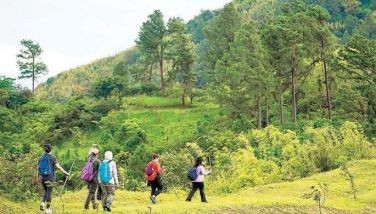Sardines

The latest in the growing list of foodstuff in short supply, or about to be, is sardines. The folks manufacturing those canned sardines have raised an alarm about the scarcity of their basic raw material some months ago.
It seems we are no longer able to catch enough of the fish to support the sardine manufacturers. The Tuna Canners Association of the Philippines told media that the fishing industry is projecting sardine shortages with fishing boats only catching 20 to 40 percent of previous levels.
Our canned sardine industry used to deliver an average volume of 355,000 metric tons annually, generating an average annual value of P10.5 billion over the last five years. Now their existence is under threat.
Perhaps, the migratory movements of fish are changing due to climate change. The habagat or southwest monsoon is also blowing the plankton away from our usual fishing grounds. So, fish like sardines, will go where the food is.
As reported earlier this week here in The STAR, Tugon Kabuhayan convenor Asis Perez said we are one of the biggest and cheapest producers of canned sardines.
“The Philippines is rich in sardines. We have six major species of sardines in our territorial waters. Sardines are vital sources of healthy and affordable protein. Over 70 percent of Filipinos eat seafood, especially sardines, at least five times per month. It is not only part of our everyday meal, but is also integral to our culture. Any claims of shortage should be resolved with tangible plans and action, because the effects are massive,” he added.
I agree. I always have a stock of canned or bottled sardines in our kitchen for quick meals. A bottle of canned sardines over newly cooked rice is as satisfying to me as it gets. Adding chopped vegetables and onions to a can or two of sardines in tomato sauce is also a favorite.
I once visited a canned sardine manufacturing plant in General Santos and saw how much employment it provides. But sardine production is largely situated in the Zamboanga Peninsula, which accounts for up to 60 percent of total production, according to Perez.
“There is an anticipated shortage. We’re not saying there’s a shortage now but it’s going in that direction,” Francisco Buencamino, executive director of the Tuna Canners Association of the Philippines, said in an online forum earlier reported here at The STAR.
Buencamino recommended allowing commercial fishing operations with a harvest area of 10.1 kilometers from shore and outward, which are classified as municipal waters.
“LGUs should allow us to fish near the shore where there are more fish. We will make sure that it will not affect municipal fishermen. We need to fish closer to build up our inventory before Dec. 1. There will be a shortage if the issue is not addressed,” he said.
There is a scheduled ban on commercial fishing between Dec. 1 and Feb. 28. Commercial fishing boats are also confined to fishing 15 kilometers from shore and beyond.
Roberto Ballon, representing a Zamboanga fisherfolk association, said that municipal fishermen can supply canneries if they are provided upgraded boats and post-harvest facilities.
An article in the Cebu Daily News and published in Ambisyon Natin 2040 on April 3, 2017 talks of a National Sardine Management Plan that the BFAR or the Bureau of Fisheries and Aquatic Resources was supposed to be preparing. With our present crisis, it probably didn’t take off.
Anyway, the article talks of the importance of sardines in our daily lives:
“Sardines are terribly underestimated. They are rich in vitamins and minerals and can supply 75 percent of our daily recommended phosphorus needed to have healthy bones and teeth. The sardines sector provides revenues for our fishers, and jobs as small-scale entrepreneurs in the dried and smoked fish industry, and factory workers in the canning and bottling sectors.
“Though they might be pint-sized, sardines and other ‘forage’ fish play mammoth roles in marine ecosystems from Peru to the Philippines. Sardines are the basis for ocean food chains that support giants like whales, seals and sharks. They’re also a vital source of healthy, affordable protein for communities around the world.”
But, the article concedes, overfishing has not spared our sardine sub-sector. The Visayan Seas used to be the number one producer of sardines, but the fish populations have severely dropped. Thus, closed seasons based on spawning cycles for commercial sardines have been implemented in the Zamboanga Peninsula and the Visayan Sea, plus part of the Tañon Strait.
A BFAR official said “there are over 800,000 fisherfolk engaged in capture fishing. That is nearly half of the 1.7 million registered fisherfolk across the country, almost a million people dependent on sardines and other fish for their everyday living.”
The current crisis didn’t happen overnight. As in the other areas of the agriculture, fisheries and forestry sector, this crisis developed over the years due to neglect by the government and greed by the fishing community.
The bleak prospects for our fishing industry are due to overfishing, illegal fishing and habitat destruction combined with increased demand for fish and population growth.
In inland waters, pollution has contributed to plunging fish harvest.
“The increasing use of feed and chemicals in milkfish, tilapia, and shrimp culture is not only polluting inland waters, but also reduces fish catch and endangers public health,” a fishery official said.
Sayang. Our fisheries sector makes a significant contribution to the national economy in terms of income and employment. Total fish production was estimated at 4.65 million metric tons, and the fisheries sector contributed almost 4.33 billion dollars to the country’s economy in 2015 (BFAR, 2016).
And let us not forget the negative impact of China’s encroachment on our Exclusive Economic Zone. Chinese fishing vessels protected by the Chinese Coast Guard get what is rightfully ours in that portion of the West Philippine Sea.
Indonesia and Vietnam have vigorously fought off such encroachments. Indonesia has even destroyed Chinese fishing vessels caught within their EEZ. In our case, Duterte’s (and now Junior’s) policy of kowtowing to China has worked against our national interest.
That’s the sad story of our lives.
Boo Chanco’s email address is [email protected]. Follow him on Twitter @boochanco.
- Latest
- Trending





























